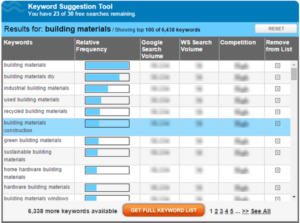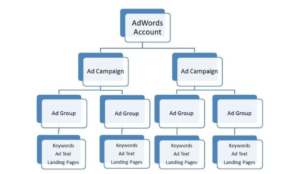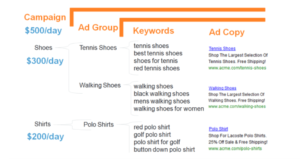In an increasingly competitive modern marketplace, marketers need to gain a competitive advantage. Search Engine Marketing (SEM) is amongst the most powerful business products and allows you to grow your business.
SEM aids businesses to gain market online by purchasing Ads on search engine platforms such as Google, Yahoo, and Bing. The SEM practices revolve around the promotion of websites in SERPs to optimize the brand presence and conversions.
SEM utilizes paid and unpaid advertising means to optimize the promotion of online businesses and we can use SEM to market a business using paid advertisements that appear on search engine result pages (SERPs). Advertisers bid on keywords that users of services such as Google and Bing might enter when looking for certain products or services.
Advertisers are provided with the opportunity for their ads to appear alongside results for those search queries.
The PPC ads come in a variety of formats, ranging from small, text-based ads, whereas others, such as product listing ads (PLAs or Shopping ads) which are more visual and product-based and allow the customers to see important information at-a-glance, such as price and reviews.
Search engine marketing’s greatest strength is that it offers advertisers the opportunity to put their ads together to motivate customers who are ready to buy at the precise moment they’re ready to make a purchase. No advertising medium can do this which is why SEM is so effective.

Here’re some of the ways to scale-up your SEM campaigns:
1) Keyword Research – Keyword research is very basic in search engine marketing (SEM). Keyword management strategy helps marketers identify keywords that are relevant to their businesses and there are a variety of tools available in the marketplace to assist marketers to do that including Free Keyword Tool.

WordStream’s Free Keyword Tool provides marketers with a range of information. Marketers can also use Google Trends to conduct Keyword Research in Google and its general competitiveness.

Keyword research can also be used to find negative keywords that include the search terms that marketers should exclude from their campaigns. Keywords with high commercial intent indicate a strong intention to buy and include the ones such as buy, discounts, deal, coupons and free shipping.
2) Keywords and Account Structure – Account structure is a crucial aspect of keywords essential for the success of search engine marketing campaigns.
Logical keyword grouping & account structure help marketers achieve optimal click-through rates, lower costs-per-click and results in overall greater account performance.
With keyword research, marketers can think about the best structure for their accounts. Marketers can structure their AdWords and Bing Ad accounts in the following ways for optimal results:

An optimally structured account is comprised of the following 5 distinct elements:
- Ad Campaigns
- Ad groups
- Keywords
- Ad text and
- Landing Pages
Ad campaigns should always focus on multiple cases and on similar products or services. Ad groups allow marketers to subcategorize campaigns for relevance.
3) Conduct Ad Auction for Search Engine Marketing – All ads go through an auction before appearing on the SERPs. Ad auction in Google Adwords work from the following mechanism:
Firstly, the ad auction process is conducted and every time someone enters a search query into Google, advertisers identify the keywords they want to bid on and state the amount that they’re willing to pay per click. The ads appear alongside the results relating to those keywords. Once Google determines the keywords that they have to bid on, the ads are entered into the ad auction.
The minimum bid is the maximum amount that one has specified before they wish to pay for a click. Quality Score is a metric that is chosen based on the overall quality of their advertisement. These metrics are calculated by Google during the auction to determine the placement of advertisements. The calculation yields what is termed ad rank.
4) Quality Scores are Important in Search Engine Marketing (SEM) – Google Adword’s Quality Score consists of half of the ad rank formula, and it is amongst the most crucial metrics that search engine marketers can focus on. High-Quality Scores help marketers in achieving better ad positions at lower costs because Google prioritizes ads that are relevant to the users’ queries.
5) Perform A/B Testing to Complement Your SEM Endeavors – To increase the efficiency of their spending, marketers need to optimize the quality of the traffic received on the website for conversions. A/B testing landing page is an easy way to maximize your spend by optimizing for the average order value or revenue per page.
Optimizing your landing page can increase your Quality Score with search engine marketing networks, and thereby reduces your average CPC.
The best practice, therefore, is to ensure that the marketers can stay competitive based on the amount of competition that exists for the keyword.
6) Research Keyword Volume and Competition and Analyze Keyword Cost – To get results from the ad investments you need to ensure that people are searching for your target keywords. High volume keywords attract more competition and, in some cases are less relevant.
The real challenge remains to balance demand (volume) and budget (competition).
Ad placement is determined by the bid marketers to specify the keyword and quality score that Google has given to their ads. Higher bids and high-quality ads win the best placement.
While high-competition keywords end up being more expensive, bidding too low means that your ads wouldn’t be visible.
7) Synchronize Your Account & Campaign Structure – If marketers lump all their keywords together in a single bucket and display one ad for the aggregate lot, still the budget would be eaten up by a handful of high-volume keywords and the quality score would be adversely impacted.
Therefore, structuring your Google Ads profile properly becomes so important, as has been displayed in the example below:

Google Ads campaign organization is comprised of several levels:
- Ad – The copy that’s displayed for keywords that have been chosen.
- Keywords – These comprise the keywords that the marketers are bidding on.
- Ad Group – These comprise the sets of keywords grouped by theme.
- Campaign – The campaign should be of the highest level for managing ad groups.
At each level, marketers need to determine what’s working and what’s not and make wiser decisions about how money is being spent.
At the end of the day when your keywords are chosen and your account is structured, marketers still need to write good ads and “earn” the click.
An ad is made up of few components:
- Title
- Display URL and
- Description

8) Choose the Best SEM Tools – SEM isn’t a set-it-and-forget-it-activity. Ongoing PPC management is required to eliminate budget waste, optimize keywords, and experiment with ads that are being bided for. This way the marketers can optimize their ROI endeavors.
Marketers need to write a great ad that makes their offers look attractive and for this purpose, they can take the help of the following SEM tools:
- HubSpot’s Ad Tracking Software
- SEMrush
- Google Trends
- io
- Google Ads Keyword Planner
- SpyFu and
- WordStream
9) Run re-marketing Campaigns – Re-marketing campaigns assist in improving the ROI of several campaigns are assist in ROI optimization for the companies. If a visitor is about to close a purchase or shows behavioral patterns that suggest that he’s interested in learning more, re-marketing campaigns ensure that he is reminded of the offering by your brands.
Remarketing campaigns allow the potential buyers to get back to the landing page and follow through with the purchase.
10) Optimize the Landing Pages – LPO (Landing Page Optimization) assists in fulfilling the needs of the visitors. It helps them in discovering the information or product that the prospective buyers are looking for. Marketers can A/B test and experiment with different offers and call-to-action phrases to see what drives the conversions for their company.
Marketers can run A/B testing to see which version of their landing page fares better. Concise up-front content is an indispensable part of an effective landing page.
Conclusion
Search Engine Marketing (SEM) is amongst the most important marketing channels to generate website traffic. It compliments SEO & content marketing gets your company at the top of the search engine result pages (SERPs).
Employing the above strategies ensures that marketers get the maximum ROI of their SEM endeavors.
The post Top 10 Tips to Scale-up Your SEM Campaigns for Optimum ROI in 2021 appeared first on Tweak Your Biz.
Top 10 Tips to Scale-up Your SEM Campaigns for Optimum ROI in 2021 posted first on https://tweakyourbiz.com/
No comments:
Post a Comment